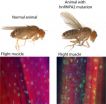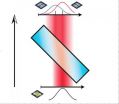(Press-News.org) A two-year-old child born with HIV infection and treated with antiretroviral drugs beginning in the first days of life no longer has detectable levels of virus using conventional testing despite not taking HIV medication for 10 months, according to findings presented today at the Conference on Retroviruses and Opportunistic Infections (CROI) in Atlanta.
This is the first well-documented case of an HIV-infected child who appears to have been functionally cured of HIV infection—that is, without detectable levels of virus and no signs of disease in the absence of antiretroviral therapy.
Further research is needed to understand whether the experience of the child can be replicated in clinical trials involving other HIV-exposed children, according to the investigators.
The case study was presented at the CROI meeting by Deborah Persaud, M.D., associate professor of infectious diseases at the Johns Hopkins Children's Center in Baltimore, and Katherine Luzuriaga, M.D., professor of pediatrics and molecular medicine at the University of Massachusetts Medical School in Worcester. These two pediatric HIV experts led the analysis of the case. The National Institute of Allergy and Infectious Diseases (NIAID) and the Eunice Kennedy Shriver National Institute of Child Health and Human Development (NICHD), both components of the National Institutes of Health, provided funding that supported the work of Drs. Persaud and Luzuriaga and other investigators involved in the analysis of the case.
"Despite the fact that research has given us the tools to prevent mother-to-child transmission of HIV, many infants are unfortunately still born infected. With this case, it appears we may have not only a positive outcome for the particular child, but also a promising lead for additional research toward curing other children," said NIAID Director Anthony S. Fauci, M.D.
In July 2010, the child was born prematurely in Mississippi at 35 weeks, to an HIV-infected mother who had received neither antiretroviral medication nor prenatal care.
Because of the high risk of exposure to HIV, the infant was started at 30 hours of age on liquid antiretroviral treatment consisting of a combination of three anti-HIV drugs: zidovudine, lamivudine, and nevirapine. The newborn's HIV infection was confirmed through two blood samples obtained on the second day of life and analyzed through highly sensitive polymerase chain reaction (PCR) testing. PCR tests conducted on separate occasions that indicate the presence of HIV in an exposed infant are considered to have confirmed the diagnosis of infection.
The baby was discharged from the hospital at 1 week of age and placed on liquid antiretroviral therapy consisting of combination zidovudine, lamivudine and co-formulated lopinavir-ritonavir. This drug combination is a standard regimen for treating HIV-infected infants in the United States.
Additional plasma viral load tests performed on blood from the baby over the first three weeks of life again indicated HIV infection. However, by Day 29, the infant's viral load had fallen to less than 50 copies of HIV per milliliter of blood (copies/mL).
The baby remained on the prescribed antiretroviral treatment regimen until 18 months of age (January 2012), when treatment was discontinued for reasons that are unclear. However, when the child was again seen by medical professionals in the fall of 2012, blood samples revealed undetectable HIV levels (less than 20 copies/mL) and no HIV-specific antibodies. Using ultrasensitive viral RNA and DNA tests, the researchers found extremely low viral levels.
Today, the child continues to thrive without antiretroviral therapy and has no identifiable levels of HIV in the body using standard assays. The child is under the medical care of Hannah Gay, M.D., a pediatric HIV specialist at the University of Mississippi Medical Center in Jackson. Researchers will continue to follow the case.
"This case suggests that providing antiretroviral therapy within the very first few days of life to infants infected with HIV through their mothers via pregnancy or delivery may prevent HIV from establishing a reservoir, or hiding place, in their bodies and, therefore, achieve a cure for those children," said Dr. Persaud.
###
NIAID and NICHD provided funding that supported the collaborating investigators involved in the analysis of the HIV-infected child through the International Maternal Pediatric Adolescent AIDS Clinical Trials Network's (IMPAACT) cooperative agreement grant AI066832. Analysis was also performed by Tae-Wook Chun, Ph.D., a lead investigator in NIAID's Laboratory of Immunoregulation in Bethesda, Md. The Foundation for AIDS Research (amfAR) also contributed funding.
For more information about NIAID's HIV/AIDS cure research, see the NIAID HIV/AIDS Web portal.
NIAID conducts and supports research—at NIH, throughout the United States, and worldwide—to study the causes of infectious and immune-mediated diseases, and to develop better means of preventing, diagnosing and treating these illnesses. News releases, fact sheets and other NIAID-related materials are available on the NIAID website at http://www.niaid.nih.gov.
About the National Institutes of Health (NIH): NIH, the nation's medical research agency, includes 27 Institutes and Centers and is a component of the U.S. Department of Health and Human Services. NIH is the primary federal agency conducting and supporting basic, clinical, and translational medical research, and is investigating the causes, treatments, and cures for both common and rare diseases. For more information about NIH and its programs, visit www.nih.gov.
NIH...Turning Discovery Into Health END
Toddler 'functionally cured' of HIV infection, NIH-supported investigators report
Discovery provides clues for potentially eliminating HIV infection in other children
2013-03-04
ELSE PRESS RELEASES FROM THIS DATE:
A billion deaths from tobacco are a key obstacle to global development
2013-03-04
If the word's nations are going to prevent tobacco smoking from causing one projected billion deaths by the end of this century, they must:
Make tobacco control part of the agendas of United Nation's and other development agencies worldwide;
Assure every sector of a nation including health, trade and finance officials work collectively to protect not only health but the harm tobacco places on their economy by passing laws to reduce use;
Place health as the centerpiece of any decision on a trade treaty that includes tobacco;
Diligently work toward a goal of reducing ...
Was King Richard III a control freak?
2013-03-04
University of Leicester psychologists have made an analysis of Richard III's character – aiming to get to the man behind the bones.
Professor Mark Lansdale, Head of the University's School of Psychology, and forensic psychologist Dr Julian Boon have put together a psychological analysis of Richard III based on the consensus among historians relating to Richard's experiences and actions.
They found that, while there was no evidence for Shakespeare's depiction of Richard III as a psychopath, he may have had "intolerance to uncertainty syndrome" – which may have manifested ...
International aid and advocacy groups are influenced by their home countries' cultures
2013-03-04
In February, Greenpeace activist and actress Lucy Lawless, star of "Xena: Warrior Princess," was sentenced to 120 hours of community service for boarding a Shell oil rig to protest offshore Arctic drilling. Dramatic protests by Netherlands-based Greenpeace contrast sharply with the lobbying and letter-writing of the U.S.-based Sierra Club. The differences among those two groups and other international non-governmental organizations (INGOs) reflect the cultures of the nations where they are based, according to research by a University of Missouri political scientist. Individuals ...
Vortex loops could untie knotty physics problems
2013-03-04
University of Chicago physicists have succeeding in creating a vortex knot—a feat akin to tying a smoke ring into a knot. Linked and knotted vortex loops have existed in theory for more than a century, but creating them in the laboratory had previously eluded scientists.
Vortex knots should, in principle, be persistent, stable phenomena. "The unexpected thing is that they're not," said Dustin Kleckner, a postdoctoral scientist at UChicago's James Franck Institute. "They seem to break up in a particular way. They stretch themselves, which is a weird behavior."
This behavior ...
Solutions Real Estate's Massive Success and Continued Growth is the Hottest Topic in San Diego Real Estate News Today
2013-03-04
Matt Johnson fell in love with San Diego in 1998, and has resided here ever since.
He is familiar with the local neighborhoods inside and out, and has the ability to assist you in selecting the best one for your family's needs.
Matt got his start in real estate at the age of 9, helping his Dad turn dilapidated old houses into the gem of the neighborhood. He later continued on that tradition, becoming a professional home renovator with operations in two states. Several years later, he realized his passion was in the sales and marketing side, so he obtained his license ...
Researchers discover how to shutdown cancer's powerful master protein
2013-03-04
NEW YORK (March 3, 2013) -- The powerful master regulatory transcription factor called Bcl6 is key to the survival of a majority of aggressive lymphomas, which arise from the B-cells of the immune system. The protein has long been considered too complex to target with a drug since it is also crucial to the healthy functioning of many immune cells in the body, not just B cells gone bad.
But now, in the journal Nature Immunology, researchers at Weill Cornell Medical College report that it is possible to shut down Bcl6 in the cancer, known as diffuse large B-cell lymphoma ...
7 genetic risk factors found to be associated with common eye disorder
2013-03-04
An international group of researchers has discovered seven new regions of the human genome—called loci—that are associated with increased risk of age-related macular degeneration (AMD), a leading cause of blindness. The AMD Gene Consortium, a network of international investigators representing 18 research groups, also confirmed 12 loci identified in previous studies. The findings are reported online today in the journal Nature Genetics. Supported by the National Eye Institute (NEI), a part of the National Institutes of Health, the study represents the most comprehensive ...
Scientists identify 'clean-up' snafu that kills brain cells in Parkinson's disease
2013-03-04
March 3, 2013— (Bronx, NY) — Researchers at Albert Einstein College of Medicine of Yeshiva University have discovered how the most common genetic mutations in familial Parkinson's disease damage brain cells. The study, which published online today in the journal Nature Neuroscience, could also open up treatment possibilities for both familial Parkinson's and the more common form of Parkinson's that is not inherited.
Parkinson's disease is a gradually progressing disorder of the nervous system that causes stiffness or slowing of movement. According to the Parkinson's ...
Adding to the list of disease-causing proteins in brain disorders
2013-03-04
PHILADELPHIA – A multi-institution group of researchers has found new candidate disease proteins for neurodegenerative disorders. James Shorter, Ph.D., assistant professor of Biochemistry and Biophysics at the Perelman School of Medicine, University of Pennsylvania, Paul Taylor, M.D., PhD, St. Jude Children's Research Hospital, and colleagues describe in an advanced online publication of Nature that mutations in prion-like segments of two RNA-binding proteins are associated with a rare inherited degeneration disorder affecting muscle, brain, motor neurons and bone (called ...
Getting around the Uncertainty Principle
2013-03-04
Researchers at the University of Rochester and the University of Ottawa have applied a recently developed technique to directly measure for the first time the polarization states of light. Their work both overcomes some important challenges of Heisenberg's famous Uncertainty Principle and also is applicable to qubits, the building blocks of quantum information theory.
They report their results in a paper published this week in Nature Photonics.
The direct measurement technique was first developed in 2011 by scientists at the National Research Council, Canada, to measure ...
LAST 30 PRESS RELEASES:
Making lighter work of calculating fluid and heat flow
Normalizing blood sugar can halve heart attack risk
Lowering blood sugar cuts heart attack risk in people with prediabetes
Study links genetic variants to risk of blinding eye disease in premature infants
Non-opioid ‘pain sponge’ therapy halts cartilage degeneration and relieves chronic pain
AI can pick up cultural values by mimicking how kids learn
China’s ecological redlines offer fast track to 30 x 30 global conservation goal
Invisible indoor threats: emerging household contaminants and their growing risks to human health
Adding antibody treatment to chemo boosts outcomes for children with rare cancer
Germline pathogenic variants among women without a history of breast cancer
Tanning beds triple melanoma risk, potentially causing broad DNA damage
Unique bond identified as key to viral infection speed
Indoor tanning makes youthful skin much older on a genetic level
Mouse model sheds new light on the causes and potential solutions to human GI problems linked to muscular dystrophy
The Journal of Nuclear Medicine ahead-of-print tip sheet: December 12, 2025
Smarter tools for peering into the microscopic world
Applications open for funding to conduct research in the Kinsey Institute archives
Global measure underestimates the severity of food insecurity
Child survivors of critical illness are missing out on timely follow up care
Risk-based vs annual breast cancer screening / the WISDOM randomized clinical trial
University of Toronto launches Electric Vehicle Innovation Ontario to accelerate advanced EV technologies and build Canada’s innovation advantage
Early relapse predicts poor outcomes in aggressive blood cancer
American College of Lifestyle Medicine applauds two CMS models aligned with lifestyle medicine practice and reimbursement
Clinical trial finds cannabis use not a barrier to quitting nicotine vaping
Supplemental nutrition assistance program policies and food insecurity
Switching immune cells to “night mode” could limit damage after a heart attack, study suggests
URI-based Global RIghts Project report spotlights continued troubling trends in worldwide inhumane treatment
Neutrophils are less aggressive at night, explaining why nighttime heart attacks cause less damage than daytime events
Menopausal hormone therapy may not pose breast cancer risk for women with BRCA mutations
Mobile health tool may improve quality of life for adolescent and young adult breast cancer survivors
[Press-News.org] Toddler 'functionally cured' of HIV infection, NIH-supported investigators reportDiscovery provides clues for potentially eliminating HIV infection in other children



